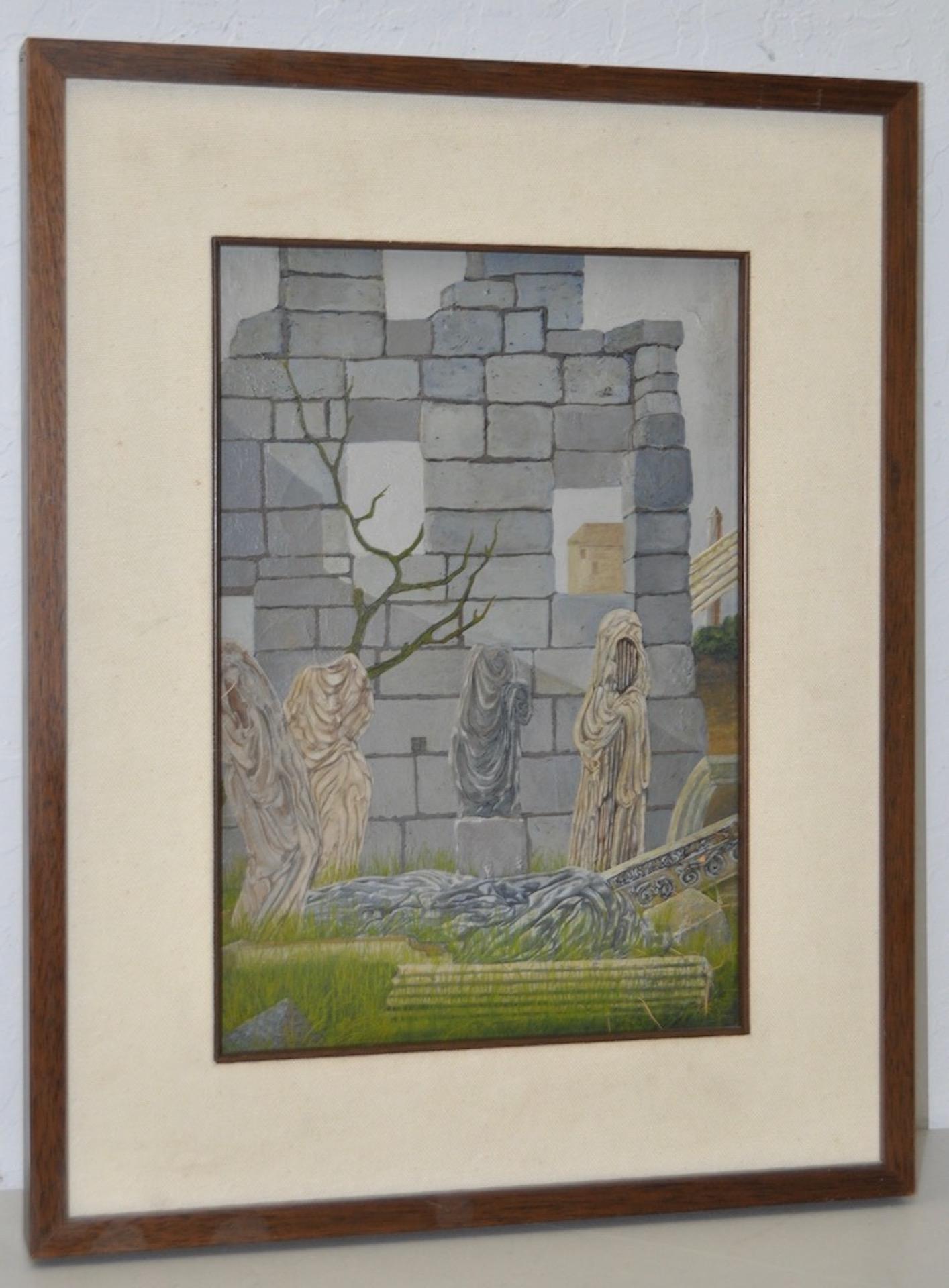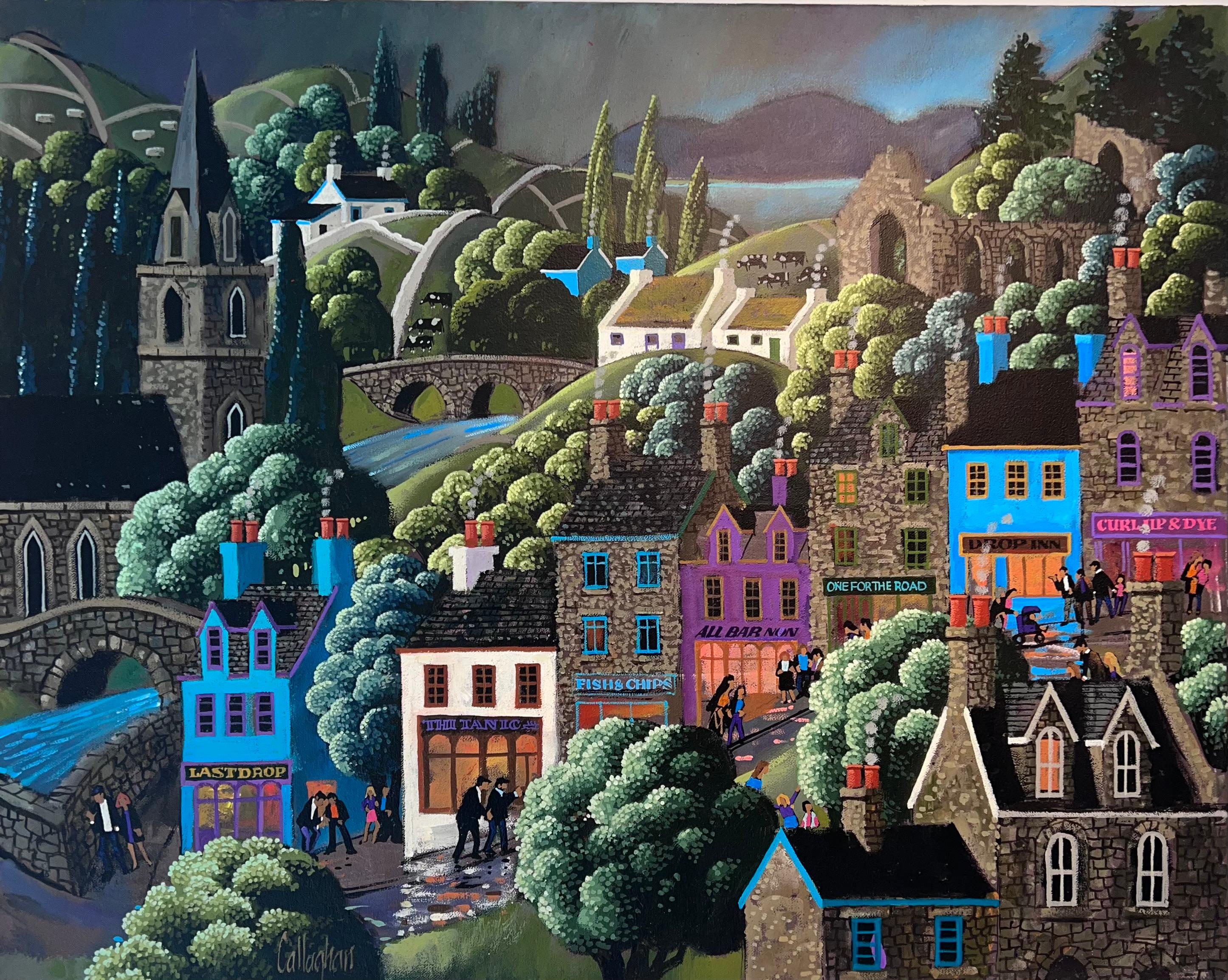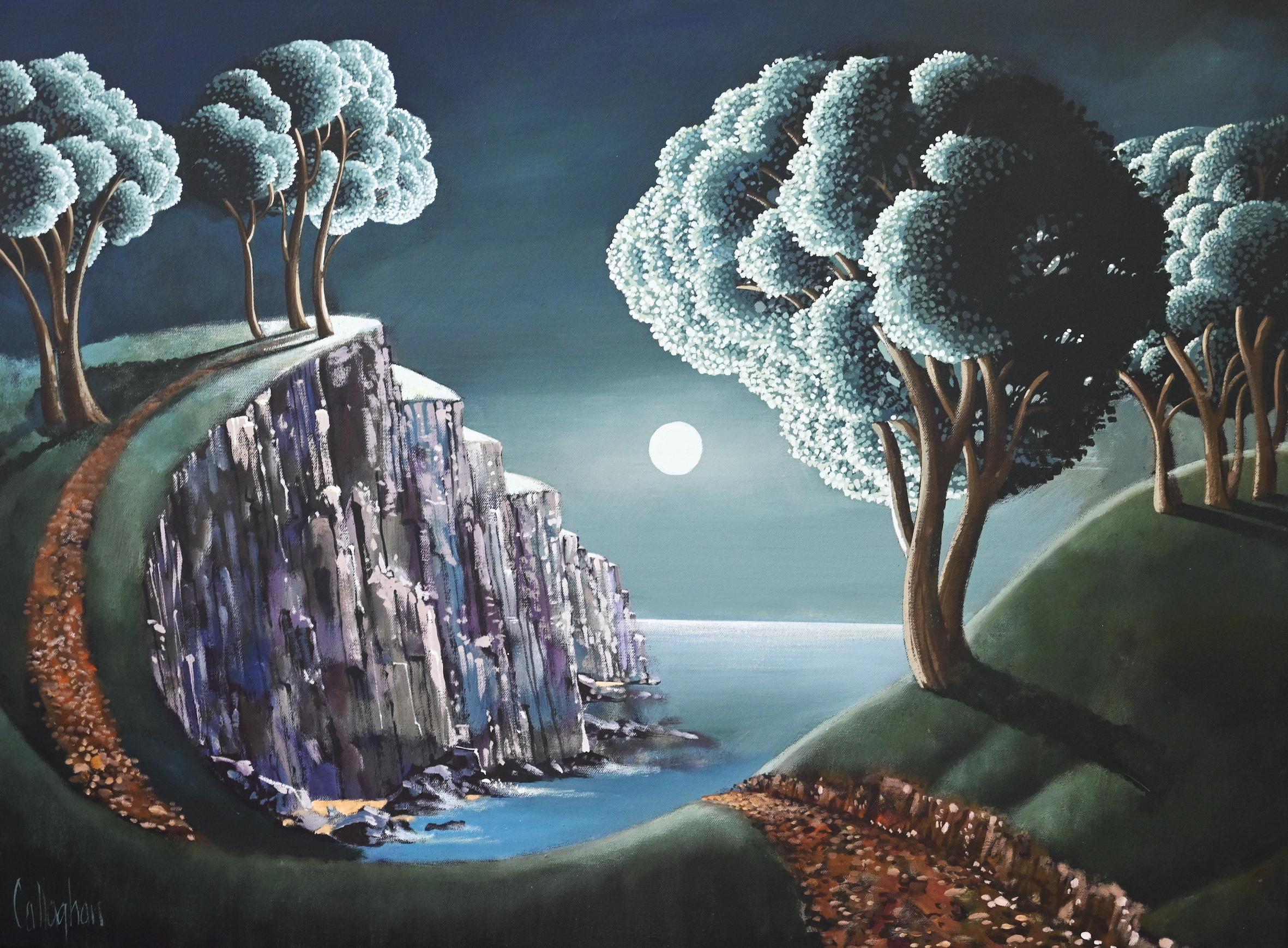Items Similar to Surrealist Vintage Woven Tapestry, Lions, Tribe of Judah, After Salvador Dali
Want more images or videos?
Request additional images or videos from the seller
1 of 10
Surrealist Vintage Woven Tapestry, Lions, Tribe of Judah, After Salvador Dali c.1980's
c.1980's
About the Item
After Salvador Dalí (1904-1989) – Spanish painter, graphic artist and sculptor
Signed ‘Salvador Dalí, woven in the carpet lower right.
The Spanish artist’s extensive oeuvre not only includes watercolors, drawings and sculptures but also tapestries; here a fine example from the limited edition ‘The Twelve Tribes of Israel’
The tapestry was created after an etching by Salvador Dalí from 1973 with the title ‘The Tribe of Judah’, which the artist created as part of a suite to mark the 25th anniversary of the State of Israel, and in which he represented the twelve tribes of Israel. This vintage French tapestry is an impeccable textile re-creation of a rare Dali etching. This is a flat weave Aubusson style tapisserie. The edition size was 500. The tapestry is inscribed with woven ‘Salvador Dalí’ lower right
Genre: Surrealism
Subject: people, architecture rendering
Medium: textile
Salvador Dali (Spanish, 1904-1989)
Salvador Dali is considered as the greatest original artist of the surrealist art movement and one of the greatest masters of art of the twentieth century.
Dali began to study art at the Royal Academy of Art in Madrid. He was expelled twice and never took the final examinations. His opinion was that he was more qualified than those who should have examined him.
In 1928 Dali went to Paris where he met the Spanish painters Pablo Picasso and Joan Miro. He established himself as the principal figure of a group of surrealist artists grouped around Andre Breton, who was something like the theoretical "schoolmaster" of surrealism. Years later Breton turned away from Dali accusing him of support of fascism, excessive self-presentation and financial greediness.
By 1929 Dali had found his personal style that should make him famous - the world of the unconscious that is recalled during our dreams. The surrealist theory is based on the theories of the psychologist Dr. Sigmund Freud. Recurring images of burning giraffes and melting watches became the artist's surrealist trademarks. Along with Rene Magritte his is considered the greatest of the Surrealists. His great craftsmanship allowed him to execute his paintings in a nearly photo realistic style. No wonder that the artist was a great admirer of the vintage Italian Renaissance painter Raphael. Meeting Gala was the most important event in the artist's life and decisive for his future career. She was a Russian immigrant and ten years older than Dali. When he met her, she was married to Paul Eluard. In 1933 Salvador Dali had his first one-man show in New York. One year later he visited the U.S. for the first time supported by a loan of US$500 from Pablo Picasso. To evade World War II, Dali chose the U.S.A. as his permanent residence in 1940. He had a series of spectacular exhibitions, among others a great retrospective at the Museum of Modern Art in New York. He has worked in paining, sculpture, tapestry, Daum glass and prints.
Dali became the darling of the American High Society. Celebrities like Jack Warner or Helena Rubinstein gave him commissions for portraits. His artworks became a popular trademark and besides painting he pursued other activities - jewelry and dated clothing designs for Coco Chanel or film making with Alfred Hitchcock.
In 1948 Dali and Gala returned to Europe, spending most of their time either in their residence in Ligate/Spain or in Paris/France or in New York. Dali developed a lively interest in science, religion and history. He integrated things into his art that he had picked up from popular science magazines. Another source of inspiration were the great classical masters of painting like Raphael, Velasquez or the French painter Ingres.
The Dali Museum in St. Petersburg in Florida/U.S.A.
This art museum was founded in 1971 by the Dali collector A. Reynolds Morse and his wife Eleanor.
Dali Museum-Theater in Figueres, Spain
The Museum was the former Municipal Theater of Figueres.
Since 1970 the artist had dedicated his energy to transform the former Municipal Theater into a museum and art gallery. In 1974 the Theatro Museo Dali was officially opened.
- Creation Year:c.1980's
- Dimensions:Height: 55 in (139.7 cm)Width: 70 in (177.8 cm)
- Medium:
- Movement & Style:
- After:Salvador Dalí (1904 - 1989, Spanish)
- Period:
- Condition:good. minor tear on the back where the hanging rod goes through. not visible at all on front.
- Gallery Location:Surfside, FL
- Reference Number:1stDibs: LU3829787642
About the Seller
4.9
Platinum Seller
These expertly vetted sellers are 1stDibs' most experienced sellers and are rated highest by our customers.
Established in 1995
1stDibs seller since 2014
1,549 sales on 1stDibs
Typical response time: 1 hour
- ShippingRetrieving quote...Ships From: Surfside, FL
- Return PolicyA return for this item may be initiated within 3 days of delivery.
More From This SellerView All
- French Mod Surrealist Commedia dell'arte Circus Scene Oil Painting J.P. SerrierBy Jean Pierre SerrierLocated in Surfside, FLJean Pierre Serrier (French, 1934-1989) Oil on canvas painting depicting four figures Hand signed lower right. Measures (frame) 26.5" x 30" wide, and (sight) 18.25." x 22.25" wide. Jean Pierre Serrier (1934 – 1989) was a French painter known for surrealism and absurdist art. Jean-Pierre Serrier was born in Montparnasse, Paris and attended the Académie des Beaux-Arts in Paris. the son of Louis and Solange Serrier. His father fought in World War II and became a prisoner of war. In 1940, as a six-year-old, he and his mother fled Paris for Corrèze in southwest France. Childhood memories of close escapes from German bombardments would later influence his absurdist philosophy of life. Passionate about drawing, in 1951 he applied and was admitted to the École nationale supérieure des arts appliqués et des métiers d'art in Paris. He shared an attic apartment in the 16th arrondissement with fellow student Jean-Baptiste Valadié. For income, he decorated shop windows. A trip to Spain provided motifs for early works. His student work might be characterized as art naïf (Naive art). While still a student, he sold a ceramic artwork to the poet and publisher Pierre Seghers, who would later commission drawings from him. He frequented jazz clubs in Saint-Germain des Près, and while listening to Sidney Bechet at the Vieux Colombier, he met his wife, Yvette.One of the last French Surrealist and follower of Nietzsche. His art conveyed the message to all of mankind that we are only human. The other Surrealist to center his art in philosophy was Rene Magritte whose paintings reflect his understanding of Sigmund Freud. He had his first exhibition in 1955, before being sent to Algeria to complete his military service. After graduating in 1955, he was drafted for military service, spent time in Germany and Morocco, and was sent to the front lines of the Algerian War. In 1959 he exhibited works at two Parisian galleries and at Juan-les-Pins on the Côte d'Azur. From 1961, he exhibited annually at the Salon des Artistes Français. In 1962, the City of Paris purchased his painting Un dimanche In 1961, Serrier made his first visit to the United States to exhibit at a New York gallery. In 1975 and 1979, he had successful exhibitions in New Orleans, and his work was included in art and news magazines, including Time and Newsweek. Beginning in the 1950s, his works included stylized portraits similar in some ways to the "big eyes" art of Margaret Keane, though it is uncertain that either artist influenced the other. Keane painted children, and so did Serrier, sometimes from life, but Serrier’s models are usually somewhat older, though uniformly slender and with androgynous features. A gallery owner introduced Serrier to American collectors Edgar Garbisch and his wife, Bernice Chrysler (daughter of Chrysler founder Walter P. Chrysler), who had a particular interest in naïve art; they commissioned a series of portraits from Serrier. At the same time, he met Reine Ausset in Paris, who in 1961 invited him to New York to take part in an exhibition at Galerie Norval on 57th Street. The show also included work by Moïse Kisling, and the exhibition program explicitly linked the two artists, saying that Serrier, who considered Moise Kisling "the Master," had found his own technique, but "the same vision joins the grand Kisling to the young Serrier: plenitude of shapes, sureness of palette, precision in outlines." In the 1960s he began painting slender, young, androgynous figures in groups, set in sparse landscapes with suggestions of the surreal and sometimes wearing costumes of the Commedia dell'arte. In some of these paintings the eyes of the figures are completely black, a motif that would continue in his later work. In 1965, he exhibited at Forest and Reed Gallery in London. Also in 1965, he discovered the small town of Martel, and with his old roommate Jean-Baptiste Valadié purchased a house that they opened as the gallery La Licorne (The Unicorn) in 1967. Responding to the political upheavals of May 1968 in France, and following the advice of Geneva gallery owner Roger Ferrero, Serrier's work became increasingly complex, idiosyncratic, and surreal. Imagery included the Tower of Babel, bodies suspended in space, and crowds of people all dressed alike, with identical features and entirely black eyes. Mannequins, playing cards, nudes, and levitating orbs also figured in the work. In a nod to Magritte, his men sometimes wear bowler hats. Another influence may have been the works of the Franco-Belgian surrealist Gaston Bogaert (1918-2008). Serrier's first major exhibit of these works, in Geneva in 1971, was titled Le Réalisme Fantastique. (Magic Realism) In 1972, he was made a member of the Société du Salon d'Automne, under whose auspices he was invited by the Polish government to exhibit in Warsaw in 1973, as part of a cultural exchange across the Iron Curtain. In 1976, he served on the jury of the Salon d'Automne. In 1975, New Orleans gallery owner Kurt E. Schon brought his work to several cities in the United States. A copiously illustrated monograph in English, Surrealism and the Absurd: Jean Pierre Serrier, was published in 1977. Author Thomas M. Bayer wrote: Serrier's world is one where—to use Friedrich Nietzche's term—the "human herd animal" is being confronted with the overwhelming task of coping with the world, his solitude, and at times, his resignation in the face of its monstrous size and duration. It is a world where the characterless, "blind" man faces the institutions, rules and symbols that made him into the being he now is…But Serrier does not lose himself in this world he portrays. He never forgets the old French tradition, the "black" humor, à la Molière. This classical humor at times is more felt than seen, in a manner that can be terribly funny, because it is horrifying, laughable, poignant and always true. Serrier told a friend, "In each of my paintings there's a message of hope amid the crowd of stereotypical figures. It could be an escaping dirigible, or a nymphet who flees like a deer under the red and blue trees of paradise...Category
Mid-20th Century Surrealist Figurative Paintings
MaterialsOil, Canvas
- Israeli Large Vibrant Surrealist Flowers Oil PaintingBy Milia LauferLocated in Surfside, FLMilia Laufer, born Romania. From 1951 lived and worked in Safed. Together with her husband opened one of the earliest galleries in Israel, in Tiberias. Worked in watercolors and oils...Category
1950s Surrealist Still-life Paintings
MaterialsCanvas, Oil
- French Surrealist Abstract PaintingBy Georges DussauLocated in Surfside, FLGeorges DUSSAU est né le 14 Mars 1947, à Chalon-sur-Saône (France) Il vit et travaille à Mellecey (France) et à Mougins (France) 1962 - 1963 - 1964 - Ecole de dessin - Chalon-su...Category
20th Century Surrealist Abstract Paintings
MaterialsCanvas
- Atlantis, Large Surrealist Oil Painting. Viennese Fantastic RealismBy Peter KolinLocated in Surfside, FLAtlantis, A large spectacular nautical, marine magic fantasy. (without the frame it is 32X39 inches) The roots for Peter Kolin’s fascinating world of Surrealist Fantasy, Magic Realist images can be traced back to the art of Mannerism, a brief period - approximately 1520 to 1610 - between the Renaissance and Age of the Baroque. In Mannerist paintings composition had no focal point and space could be ambiguous. Surreal figures could be characterized by athletic bending and twisting with distortions, exaggerations, elastic elongation of the limbs, bizarre or graceful posturing and the rendering of the heads as uniformly small and oval. (reminds me very much of some of the compositions of Salvador Dali) The composition was full of clashing symbolist colors very unlike the balanced, natural and often dramatic colors of the High Renaissance. Mannerist works presented instability and restlessness and also showed a fondness for allegories with lascivious undertones. Kolin, an exceptionally gifted painter within this tradition, creates gorgeous and mysterious fantasies of Surrealism with each work opening a new and more exciting fantastic world. His narrative world of images and symbols is presented in his own metaphorical language but with a visual accuracy solidly rooted in technical perfection. Today Kolin is a widely acclaimed artist of the Vienna School of Fantastic Realism. (Together with, Arik Erich Brauer, Ernst Fuchs, Rudolf Hausner...Category
1980s Surrealist Figurative Paintings
MaterialsCanvas, Oil
- Large Surrealist Symbolist Painting, Peeking Child, Moorish Architectural ArchesBy Baruch ElronLocated in Surfside, FLLarge Surrealist Symbolist Painting With a peeking, peering figure of a child dressed in red in a typical Middle Eastern Architectural setting. (unframed 28.75X39.5 inches) Baruch Elron (1934–2006) was an Israeli painter best known for his unique Fantastic Realist style rich in symbols and allegories. Baruch Elron (Barbu Teodorescu) was born in Bucharest, in a family of Sephardic Jews. Baruch Elron studied Painting at the Nicolae Grigorescu Fine Arts Academy in Bucharest. Among his teachers were the great artists Corneliu Baba...Category
20th Century Surrealist Figurative Paintings
MaterialsCanvas, Oil
- European Collage Cubist Oil Painting 1960 Surrealist Interior with Vase and PipeLocated in Surfside, FLWonderful mid century, signed (illegibly) and dated. I believe it is German or Austrian but not certain. It is an assemblage of textures and materials collaged together, done in bright jewel tones. Avant Garde painting...Category
1960s Surrealist Interior Paintings
MaterialsCanvas, Felt, Mixed Media, Oil, Laid Paper
You May Also Like
- Vintage Surreal Oil Painting on Canvas c.1940s to 1950s.Located in San Francisco, CAVintage Surreal Oil Painting on Canvas c.1940s to 1950s. Classic Surrealism brought to life on canvas by a very talented artist. The painting has no visible signature. Canvas dimen...Category
Mid-20th Century Surrealist Abstract Paintings
MaterialsCanvas, Oil
- Her Majesty the Muse figurative interior painting mint green female success loveLocated in Zofingen, AGHer Majesty The Muse I remember the words our teacher said “Do not wait for a sudden inspiration, for a visit from the Muse. You should begin working, otherwise the Muse will pass b...Category
2010s Surrealist Figurative Paintings
MaterialsCanvas, Oil
- The High St - original surrealism landscape cityscape painting- contemporary ArtLocated in London, Chelsea"The High St" by George Callaghan beckons viewers into a bustling thoroughfare teeming with life and energy. Unlike some of George's other tranquil la...Category
21st Century and Contemporary Surrealist Landscape Paintings
MaterialsCanvas, Oil
- Midnight on the Water- original surrealism landscape painting - contemporary ArtLocated in London, Chelsea"Midnight on the Water and How It Used to Be" by George Callaghan is a captivating exploration of a mystical nocturnal landscape, where the boundaries...Category
21st Century and Contemporary Surrealist Landscape Paintings
MaterialsCanvas, Oil
- Ancient Stock Route - original surrealism landscape painting - contemporary ArtLocated in London, Chelsea"Ancient Stock Route" by George Callaghan is a mesmerizing journey through a dreamlike realm, where reality merges with imagination in a captivating d...Category
21st Century and Contemporary Surrealist Landscape Paintings
MaterialsCanvas, Oil
- Passed the Poplars - original surrealism landscape painting - contemporary ArtLocated in London, ChelseaTitle: "Passed the Poplars" by George Callaghan invites viewers into a serene and enchanting landscape, where earthy tones juxtapose harmoniously with...Category
21st Century and Contemporary Surrealist Landscape Paintings
MaterialsCanvas, Oil





